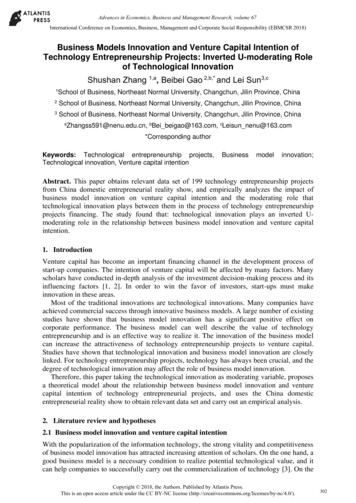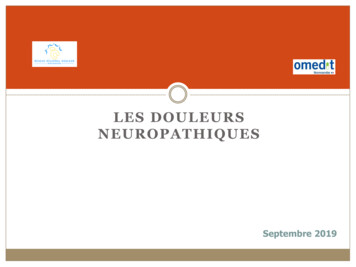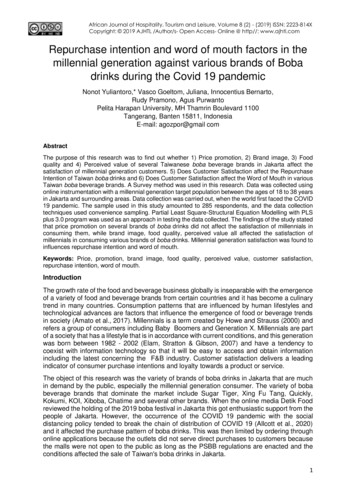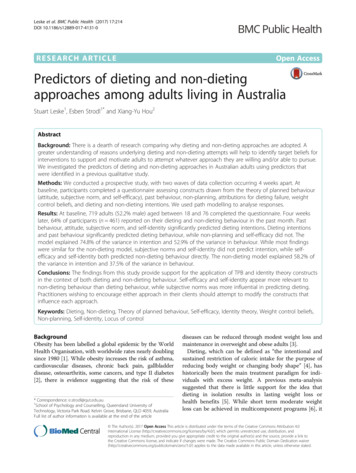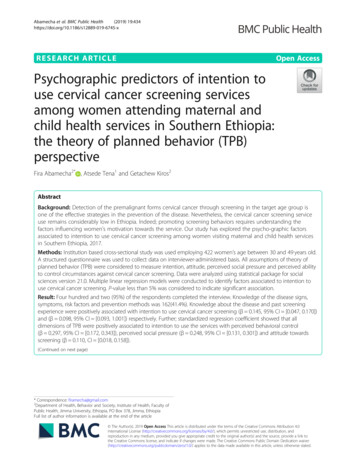
Transcription
Abamecha et al. BMC Public Health(2019) EARCH ARTICLEOpen AccessPsychographic predictors of intention touse cervical cancer screening servicesamong women attending maternal andchild health services in Southern Ethiopia:the theory of planned behavior (TPB)perspectiveFira Abamecha2* , Atsede Tena1 and Getachew Kiros2AbstractBackground: Detection of the premalignant forms cervical cancer through screening in the target age group isone of the effective strategies in the prevention of the disease. Nevertheless, the cervical cancer screening serviceuse remains considerably low in Ethiopia. Indeed; promoting screening behaviors requires understanding thefactors influencing women’s motivation towards the service. Our study has explored the psycho-graphic factorsassociated to intention to use cervical cancer screening among women visiting maternal and child health servicesin Southern Ethiopia, 2017.Methods: Institution based cross-sectional study was used employing 422 women’s age between 30 and 49 years old.A structured questionnaire was used to collect data on interviewer-administered basis. All assumptions of theory ofplanned behavior (TPB) were considered to measure intention, attitude, perceived social pressure and perceived abilityto control circumstances against cervical cancer screening. Data were analyzed using statistical package for socialsciences version 21.0. Multiple linear regression models were conducted to identify factors associated to intention touse cervical cancer screening. P-value less than 5% was considered to indicate significant association.Result: Four hundred and two (95%) of the respondents completed the interview. Knowledge of the disease signs,symptoms, risk factors and prevention methods was 162(41.4%). Knowledge about the disease and past screeningexperience were positively associated with intention to use cervical cancer screening (β 0.145, 95% CI [0.047, 0.170])and (β 0.098, 95% CI [0.093, 1.001]) respectively. Further; standardized regression coefficient showed that alldimensions of TPB were positively associated to intention to use the services with perceived behavioral control(β 0.297, 95% CI [0.172, 0.343]), perceived social pressure (β 0.248, 95% CI [0.131, 0.301]) and attitude towardsscreening (β 0.110, CI [0.018, 0.158]).(Continued on next page)* Correspondence: firamecha@gmail.com2Department of Health, Behavior and Society, Institute of Health, Faculty ofPublic Health, Jimma University, Ethiopia, PO Box 378, Jimma, EthiopiaFull list of author information is available at the end of the article The Author(s). 2019 Open Access This article is distributed under the terms of the Creative Commons Attribution 4.0International License (http://creativecommons.org/licenses/by/4.0/), which permits unrestricted use, distribution, andreproduction in any medium, provided you give appropriate credit to the original author(s) and the source, provide a link tothe Creative Commons license, and indicate if changes were made. The Creative Commons Public Domain Dedication o/1.0/) applies to the data made available in this article, unless otherwise stated.
Abamecha et al. BMC Public Health(2019) 19:434Page 2 of 9(Continued from previous page)Conclusion: Overall; the intention to use cervical cancer screening was a function of attitude, perceived social pressureand perceived behavioral control confirming the hypothesis of the study. None of the socio-demographic variableswere associated to intention. Health behavior change interventions should focus on increasing knowledge andempowering women that enable them to evaluate their control beliefs and develop ability against social norms andcircumstances that compete with the use of cervical cancer screening services.Keywords: Cervical cancer, Screening, Intention, TPB, EthiopiaBackgroundCervical cancer is a global public health problem accounting the fourth most common cancer-affectingwomen worldwide. The world has estimated populationof 2,716 million women aged 15 years and older who areat risk of developing cervical cancer. About 527,624women are already diagnosed with cervical cancer and265,672 die from the disease annually. About; 87% alldeaths from cervical cancer occurs in sub-Sahara Africancountries [1]. The high prevalence of cervical cancer isalso evident in the case of Ethiopia. There were 27.19million women aged 15 years and older who are at riskof developing cervical cancer [2]. Every year; 7,095 Ethiopian women are diagnosed with cervical cancer and4,732 die from the disease. It has been shown that thehighest cancer-related mortality rate; comprising 16.5%;occurred among women in Ethiopian in 2015 [3].Despite its proven importance, rates of attendance forscreening programs vary widely, and are considerablylow. The low prevalence of early cervical cancer screening and limited access to its treatments largely attributedto differences in diagnosis and subsequent mortalityfrom the disease among high and low income countries.For instance; the screening uptake for cervical cancer inthe three developing regions was only 6%, 12%, and 8.3%in South Africa, Bhutan, and Nigeria respectively [4–6].It has been recorded that only 1% of eligible women received the cervical cancer screening services in Ethiopiawith about 90% of them never had a pelvic examinationat all [7]. The death from cervical cancer is found to behigh among women who didn’t undergo screening andthose who have sexual health risks like early sexual practices, multiple sexual partners and multiple pregnancies[8]. Furthermore; delayed treatment seeking behaviorwith advanced stage of the disease is common indeveloping countries which could markedly leads todiminished chance of success of treatment even withmultiple modalities including brachytherapy, radiotherapy and chemotherapy [9].Understanding the competingand motivating factors affecting the CCS behavioramong women in the context of Ethiopia helps toenhance the screening and treatment efforts. In additionto their limited quantity; most previous studies conducted in the Ethiopia narrowly emphasized on cognitivedimensions and accessibility of service related factors[10–12]. However, none of them has comprehensivelyaddressed the complex normative dimensions and circumstances that importantly influence the women’sdecision-making process and intention to use CCS.Hence, the study is the first of its kind in Ethiopia inapplying the most widely applied and successfullystudied behavioral theory to predict the intended use ofcervical cancer screening services.The Theory of Planned Behavior (TPB), which is anextension of the Theory of Reasoned Action (TRA), wasdeveloped by Ajzen in 1990. It is one of the most widelyemployed social-cognitive theories to understand therelationship between intentions and behavior [13].According to the TPB, attitude towards a behavior, subjective norms and perceived behavioral control (PBC)determine intention which in turn predicts the behavior[14]. The TPB has been found to be the most parsimonious model in predicting intentions and various behavioral outcomes [15]. A meta-analysis showed that theTPB accounted for 39% of the variance in intentions and27% of the variance in behavior across a broad spectrumof behaviors [16]. Further; TPB has also been applied toscreening behaviors like breast and colorectal cancersscreening behaviors [17]. It has been found to be effective in predicting cervical cancer screening (CCS)intention in different previous studies [18–20].The current study has applied TPB due to the following important reasons. Women's decision-making is theresult of intrapersonal factors (the process of decisionmaking reflects people's values and attitudes). To act ina specific direction requires that people behave in linewith their motivation and attitudes. In addition, participating in screening services is a result of external factorsthat control or enhance the behavior. Personal factorslike one’s confidence to cope with and overcome barriersrelated to availability, affordability and accessibility ofscreening services and social supports are all supposedto determine the extent to which women decide to usethe screening services. Therefore; the aim of this currentstudy was to explore the psycho-graphic factors associated to intention to use CCS services among womenvisiting maternal and child health services. The hypothesis of the study was; women’s intention to use CCS
Abamecha et al. BMC Public Health(2019) 19:434services is a function of Attitude, Subjective norms andPBC.Operational definitionsHealth extension workers (HEW)Are trained community health workers as a part ofachieving primary health care goal. They are tasked totransfer health knowledge and skills to families theyserve.Health development army (H.D.A)These are group of women in the community selectedfrom model families (model households) as healthagents. Model households are those who have demonstrated behavior change and improved uptake ofhigh-impact health interventions of HEWs.Elicitation studyIt is an exploratory qualitative interview conducted with15–20 participants selected among target population. It’sdone to elicit important psychographic beliefs regardingthe behavioral consequences of particular behavior (i.e.CCS use in this case), the significant others and controlbeliefs for this behavior.MethodsStudy design and settingAn institution based cross-sectional study was conducted in yirgalem town, Ethiopia from March 1-30,2017. Yirgalem is one of towns located in the SouthNations Nationalities and Peoples Region (SNNPR);about 260 KM south of Addis Ababa; the capital city ofEthiopia. According to census 2007; Ethiopia; projectionfor 2016, the total population of the town was 61,260with 30,145 were male and 31,115 female of all agecategories. The town has five ‘Kebeles’ (the smallest administrative structure). There were one general hospital,one health center and seven private health institutions inthe town.Study participantsWomen age 30-49 years who were attending maternaland child health services like antenatal care (ANC), postnatal care (PNC) and family planning (FP) services inthese health institutions were included. Women whohad confirmed cancer of the cervix were excluded fromthe sample.Sample size and sampling techniquesA single population formula for mean difference calculation of finite population was used to calculate samplesize as given in the equation; n (Zα/2 σ/d)2. Where; theestimate of predicted variance in intention to CCS wastaken to be 50%, the margin of sampling error toleratedPage 3 of 9(d 0.05), the value of Z score at 95% confidence level(Zα/2 1.96). This yields a sample of n 384. Afteradding 10% for non-response; the final sample was 422women. The single population formula for mean difference was used since the objective of the study was topredict intention to CCS among pregnant women whichwas measured on summative scales to be treated as continuous variable in the subsequent analyses. Further,since there was no evidence of the value of σ (variance)on similar issue of the current study in Ethiopia); the σ 50% or 0.5 which yields adequate sample for betterinference was used in this study.There were nine health institutions (one public generalhospital, one public health center and seven privateclinics) in the town of which only five of them wereproviding cervical cancer screening services in 2017.Systematic sampling technique was used to select actualparticipants. Before deciding on the sampling interval(kth value); one-month prior clients flow rate for maternal and child health services was calculated assumingno/low fluctuation flow rates in the next one month ofdata collection period. There were a total of 902 clientflows of all health facilities in the month preceding.Indeed, we would expect the total flow rate during thenext one month data collection period to be nearly 902.By dividing 902 to sample size; 902/422 2. So; everyother woman visiting maternal and child health clinicsin each health facility were approached and exit interview was conducted at each services unit.Data collectionQuestionnaire was adapted from previous studies[14, 20–22] and modified based on the result of elicitation study. It was developed in English and translatedinto local languages, ‘Sidamic’ and ‘Amharic’ by languageexperts. Data were collected using interviewer administered basis as an exit interview. In addition to constructsof TPB, the questionnaire covered sociodemographic information, past screening practices, knowledge about CCSand medical and reproductive histories. Refreshmenttraining was given for field workers. Before developingquantitative instrument; we conducted an elicitation studyusing in-depth interview to explore relevant salient beliefsamong a study population regarding perceived outcomeexpectation of using CCS services, perceived social normative influences and beliefs about personal autonomy inseeking the services. Fourteen women participants wererecruited from health institution not included in the actualstudy. Participants are encouraged to reveal their beliefsregarding benefits using CCS services, the group of peoplethey think would encourage or discourage them to usingof CCS services and factors that would either hinder orfacilitate their use of CCS services. Furthermore, thecultural relevance and language clarity of the items in the
Abamecha et al. BMC Public Health(2019) 19:434Page 4 of 9structured questionnaires was explored via pretest whichwas conducted prior to data collection.Measurements and scoringMore specifically, the measurement and scoring techniqueused in study were adapted from previous study conducted applying the TPB [22]. To this end, intention touse CCS was measured by using four items. Responsesranged from ‘not likely at all’ (1) to ‘very likely’ (5). Composite score was done by summing up all the items.Direct attitude towards the use of CCS was measuredusing four items on semantic differential scales (SDS)measuring about the benefit/outcome of using CCSservices in the next 3 months on bipolar adjectives(words with opposite meaning). Six items were used tomeasure behavioral belief with responses ranging from‘strongly disagree (1) to ‘strongly agree’ (5). Evaluation ofCCS belief was measured by asking respondents toevaluate six salient consequences accruing from usingCCS services. Each behavioral belief was multiplied bythe score for the outcome evaluation to create a newvariable (indirect attitude) that represents the weightedscore for each behavioral belief.Four Likert scale items were used to measure directsubjective CCS norm. To assess indirect SN towardsCCS, participants were asked seven Likert scale items toindicate the extent to which they thought their healthextension workers (HEW), health development army(H.D.A), neighbors, public forum leaders and healthworkers were likely to appreciate their use of CCSservices. Similarly, we weighted each normative belief bythe score for motivation to comply belief. Then; thecomposite scores of indirect SN were created bysumming up of the weighted beliefs.Direct measure of PBC was measured by using fouritems on bipolar differential scales. High compositescore shows strong perceived ability or less difficulty tohave CCS services within the specified period of time.Six control belief items were used to measure indirectPBC ranging from unlikely to likely scale and perceivedpower of control was measured using six items on bipolar Likert scale ranging from ‘strongly disagree’ to‘strongly agree’ scored on 2 to 2 scale responseformat. The control belief items were multiplied bythose of perceived power of control of the beliefs. Summing up of these product scores yields the compositescore of indirect perceived behavioral control. In allcases, the higher scores indicate a greater value for allmeasured TPB constructs to towards the use of cervicalcancer screening services (Table 1).Knowledge about cervical cancer and screening wereassessed using 19 items with ‘Yes’ or ‘No’ responseformat about sign and symptoms, risk factors, methodsof prevention, stage of curacy, frequency of screeningand eligibility for screening. All items were scored ascontinuous variables and pulled together where themean score was computed for further analysis [23].Practice of CCS (Past behavior experience, PBE): Oneitem was used to ask respondents whether they haveever been screened for CCS by using yes/No approach.Data analysisData was checked manually for its completeness everyday during data collection period. The responses in thecompleted questionnaire were coded and entered in toTable 1 Summary of measurements and scoring of direct and belief based measures of constructs of TPB of the current studyItemsScaleScoringOutcome4Likert scale4PIntention scoreDimension (Direct measures)1.Intention (Ii)Ii12.Attitude (A)4SDS4PAi“A” scoreSNi“SN” scorePBCi“PBC” scorei¼13.Subjective norms (SN)4Likert scale4Pi¼14.Perceived behavioral control (PBC)4SDS4Pi¼1Beliefs based (Indirect measures)1.Behavioral beliefs (bbi)6Likert scale6P2.Evaluation of the beliefs (ebbi)6Likert scalei¼13.Normative beliefs (nbi)7Likert scale7P4.Motivation to comply (mci)7Likert scalei¼15.Control beliefs (cbi)Power of control (pci)6Likert scale6PKey: SDS Semantic differential scale, IA Indirect attitude, ISN Indirect SN and IPBC indirect PBCi¼1bbi ebbinbi mcicbi pci“IA” score“ISN” score“IPBC” score
Abamecha et al. BMC Public Health(2019) 19:434Epi-data version 3.1 and exported to Statistical Packagesfor Social Sciences’ (SPSS) window 21.0 for analysis (v21.0; IBM Corporation, Armonk, NY, USA). DescriptiveStatistical measures like mean and standard deviationwere done. The Pearson’s correlation analysis was carried out to examine the association between intentionand constructs of theory of planned behavior as bivariateanalysis. Similarly; an independent sample t-test and oneway ANOVA was carried out to explore the associationsbetween intention and categorical sociodemographicvariables. Those variables which have significant associations with intention to CCS at p 0.05 in bi-variateanalysis were qualified for multiple regression analysis.Multiple linear regression models were conducted toidentify independent factors associated to intention touse cervical cancer screening service. The “enter”regression technique was used to run the analysis.P-value 0.05 was considered to indicate significantassociation.Page 5 of 9Table 2 Socio-demographic characteristics of respondents inYirgalem town, Ethiopia 2017 (n 402)VariablesCategoriesFrequenciesPercentAge in nicityMarital rried36290.0ResultWidowed215.2Socio-demographic 46Self12932.1From 422 participants; 402 respondents completed theinterview and producing 95% response rate. The age ofthe respondents was ranged between 30 to 49 years withmean age of 36.40 4.791 years. The majority 278(69.2%) were protestant followed by orthodox accounting for 66 (16.4%). Most of the 288 (71.6%) of therespondents were Sidama ethnic groups. Majority of therespondents 362 (90%) were married. One hundredfifty-four; 46% of respondents were housewife. About;191 (47.5%) had completed primary school and 60(14.9%) were uneducated; who are unable to read andwrite (Table 2).Source of information, knowledge of cancer and pastcervical cancer screening practiceOut of 391 (97.3%) of respondents who have heardabout cervical cancer and cervical cancer screening,166 (42.5%) heard from mass media (radio/TV) and114(29.8%) from health workers. Regarding knowledgeabout cervical cancer and screening, 200 (44.2%), 154(39.4%), 136 (34.95%) and 193(49.4%) knew aboutsymptoms, risk factors for cervical cancer, preventionmethods, stages of treatment respectively. Withrespect to frequency and age of screening, 42(11%) ofthe respondents knew cervical cancer screening isnecessary every 5 years and 90 (23.6%) knew agegroup mostly affected. For each knowledge items,scores were summed and mean score was computed.Accordingly, only 162 (41.4%) of the respondentswere answered above the mean and considered asknowledgeable. Cervical cancer screening experienceOccupationMonthly incomeEducational statusGovernmental8821.9 5007719.2500–9999423.4 100023157.5uneducated6014.9Primary19147.5Secondary and above15137.6was low in the area, as only 36 (9.2%) had screenedfor it.The mean score of direct attitude, subjective normand PBC were 14.4 (SD 2.1), 13.71 (SD 1.97) and 13.74(SD 1.97) respectively and intention with mean score of13.14(SD 1.7). There was higher attitude score 14.40(SD 2.1) towards cervical cancer screening amongwomen (Table 3).Relationship between intention, socio demographicfactors and measures of TPB constructsTo explore association between dependent and independent variables; all the necessary bi-variate analysiswere done. These include; the Pearson’s correlation, anindependent sample t-test and one way ANOVA. Unfortunately, all the socio-demographic and pregnancy related variables were not significantly associated withintention to CCS. These variables were occupational
Abamecha et al. BMC Public Health(2019) 19:434Page 6 of 9Table 3 Descriptive statistics for components of theory of planned behavior and intention for women visiting health institution inYirgalem town (N 402)S.NConstructsNumber of itemsScale rangeScale ude44–2014.402.100.753Subjective otal1614–80––Abbreviation: PBC direct perceived behavioral control, SD Standard deviation, α Cronbach’s alphastatus, income level, educational status, number of pregnancy, number of children, and marital status, otherrisky behaviors like smoking, sexual practice, history ofsexual transmitted diseases etc. But the only variablethat emerges as significant factors was knowledge aboutcervical cancer and its screening services.However, the Pearson’s correlation coefficients showedthat all the direct measures of TPB were significantlyand positively correlated with each other and with theirrespective indirect measures. From Table 4 below; thehighest and lowest positive correlation was observedbetween intention and PBC (r 0.485, p 0.001), andbetween intention and attitude respectively. Importantly; all indirect measures of TPB were positivelyand significantly correlated with their respective directmeasures. This correlation is required to decidewhether to run or not the regression analysis to predict intention using the direct measures. Finally, allindirect measures were positively and significantlycorrelated with each other. The highest inter-indirectmeasures correlation was observed between indirectattitude and indirect subjective norm (r 0.546, p 0.001)(Table 4).knowledge and past behavioral experience (PBE) ofcervical cancer screening were entered to multivariatelinear analysis. The standardized regression coefficients,PBC was found to be the best factor (β 0.297, p 0.01)followed by subjective norm (β 0.248, p 0.01).This indicates; a unit positive change in women’s perception ofability to control over circumstances that inhibit themfrom using CCS will increase intention to use CCS by29.7% keeping other conditions constant. Women whoperceive significant others will approve of their usingCCS services will have 24.8% higher intention to useCCS than their counterparts. Similarly, a unit-positivechange in women’s attitude toward the advantage associated with the use of CCS services will increase theindividual’s intention to use it by 11% provided that allthe other factors kept unvaried. In this study, attitudewas found to be the least factor associated to intentionto CCS use (β 0.11, p 0.014).In this study; the past behavioral experience (PBE) ofusing CCS services positively predicted intention to useCCS (β 0.098, P 0.02). Intention to use CCS serviceswill significantly be increased by 9.8% for those womenwho have an experience of using the services (Table 5).Independent factors associated to intention to cervicalcancer screening and interpretationsDiscussionThe aim of this study was to determine intention to usecervical cancer screening and its associated psychometric and socio-demographic factors among women. Tothis regard, the results of this study revealed none ofsocio-demographic variables significantly predictedPrediction of behavioral intention to CCS use was conducted with all direct constructs of TPB and variablesthat were significant in bi-variate analysis. These are;attitude, subjective norms, perceived behavioral control,Table 4 Pearson’s Correlation between intention, direct and indirect measure of TPB (n 402)ComponentDADATT1DSN0.307**DSNDPBCIDAIDSNIDPBC 0.485**0.491**0.462**0.430** 1Abbreviations: DA direct attitude, DSN direct subjective norm, DPBC direct perceived behavioral control, IDA Indirect attitude, IDSN Indirect subjective norm, IDPBCindirect perceived behavioral control. “**” the correlation is significant at P 0.01
Abamecha et al. BMC Public Health(2019) 19:434Page 7 of 9intention to the contrary to previous studies conductedin Iran and somewhere else [18, 24]. This may be due tothe setting in which the study was conducted.In thisstudy, 97.3% of respondents have awareness about theexistence of cervical cancer screening services in Ethiopia.This finding is high compared to community-basedstudies done in Ethiopia in 2016 and 2010 [10, 25]. Thisdifference may be due to the population under study asthose who visit health institution may have higher chanceof getting access to information than their counterparts.The recent strong efforts for cancer prevention andcontrol program being done by Ethiopian governmentmight have a contribution to this difference. The NationalAction Plan on the Prevention and Control of ChronicNon-Communicable Diseases has addressed strategies toscale up availability and accessibility of health services forcervical cancer care through effective participatory prevention and control methods with faith organization, ization and private institutions since 2015 [26].It’s known that knowledge on causal factors andmethods of prevention is essential in the prevention ofcervical cancer. Knowledge influences individuals decision making in that knowing these factors can influencesomeone avoids or overcome them and hence escapesfrom acquiring the disease. In our study; the overallknowledge of the disease signs, symptoms, risk factorsand respective prevention methods was as low; 162(41.4%). Hence, public health education on these issuesfor women has paramount importance. However, it isrelatively higher than the finding of previous study donein Ethiopia revealing only 24.8 and 27% of the respondents know about sign and symptom, and main risk factors of cervical cancer respectively [10]. The discrepancymight be due to the difference in time of study as ourstudy was done latter after due attention has been givento cervical cancer screening services through ministry ofhealth initiatives [7].In our study; being knowledgeable about cervicalcancer and screening was significantly and positively associated with cervical cancer screening intention. Knowledge is important and necessary especially for rationalTable 5 Independent factors associated to behavioral intentionto cervical cancer screening, Yirgalem town, southern Ethiopia,2017 (n 402)VariablesStandardized βP-value95% CI for βPBC0.2970.01[0.172, 0.340]Subjective norm0.2480.01[0.131, 0.301]Attitude0.1100.01[0.018, 0.160]PBE0.0980.02[0.093, 1.001]Knowledge score0.1450.01[0.047, 0.170]Abbreviations: PBC perceived behavioral control, PBE past behavior experiencedecision of any health behavior even though; it is notsufficient. This finding suggests; knowledge might havepositive impact on attitude to influence an individualintend for screening. Similar finding was reported fromrelated studies done in China [27] and Mandalay [28].In this study, only 9.2% of the women reported theyhad screening for cervical cancer. However, it’s higherthan the country wide prevalence of CCS; which was lessthan 1% by 2008 [7]. The difference might be attributedto time variation and strong initiatives being undertakenby the government in the recent time. Ethiopia hasadopted a comprehensive National Action Plan on thePrevention and Control of Chronic Non-CommunicableDiseases (NCDs), including cancer in 2015. The countryplanned a nation-wide scale up of the screening andtreatment for cervical cancer into over 800 health facilities (one health facility per district). The NationalCancer Committee (NCC) was organized at federal levelwhich has been chaired by the late First Lady of Ethiopia[26]. Furthermore; the social desirability bias (SDB)inherent to self-reports of being screened for cervicalcancer might also have contributed to this difference.Similar to studies conducted in Latinas and Iran [18, 19],the current study has identified that the CCS experienceswas associated with cancer screening intention. To thisregard, Ajzen; the author of TPB; has explored that the roleexternal variables (e.g. past behavior experiences) in influencing intention through proximal TPB constructs [14].Further; study conducted in Ethiopia and Tanzania (oncondom and VCT use behavioral intention) showedconflicting results on the effects of past experiences on behavioral intention [22, 29, 30].According to Ajzen, theintention to perform a beh
Cervical cancer is a global public health problem ac-counting the fourth most common cancer-affecting women worldwide. The world has estimated population of 2,716 million women aged 15 years and older who are at risk of developing cervical cancer. About 527,624 women are already diagnosed with cervical cancer and 265,672 die from the disease .


![WOUND HEALING lecture.ppt [Read-Only]](/img/18/wound-healing.jpg)
